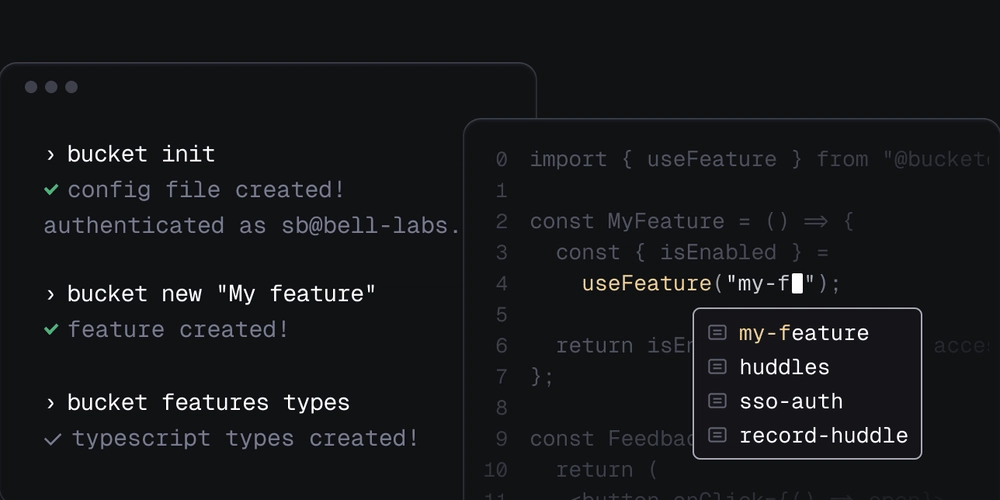Add feature flags from the command line
At Bucket, we're on a mission to help you ship the right features faster. We're building a feature flagging tool that's crafted for speed, built for B2B SaaS. We've recently shipped a command line interface (CLI) that you can use to interact with Bucket. It removes any friction in creating feature flags from the command line and helps you maintain type safety for your features. Here's what you can do with the Bucket CLI: Create new features with the new command Manage features and ensure type safety Manage companies and apps Manage authentication with login and logout To get started: npm install @bucketco/cli Create new features with type safety bucket new [featureName] This is the all-in-one command to get started quickly. Use this for the fastest way to get up and running with Bucket. Example bucket new "My Feature" [--key my-feature] [--app-id ap123456789] [--key-format custom] [--out gen/features.ts] [--format react] Options --key: Specific key for the feature --app-id: App ID to use --key-format: Format for feature keys (custom, snake, camel, etc.) --out: Path to generate TypeScript types --format: Format of the generated types (react or node) Manage features from the command line To manage your features using the Bucket CLI, use the following subcommands: bucket features create Create a new feature in your Bucket app. The command guides you through the feature creation process with interactive prompts if options are not provided. bucket features create "My Feature" bucket features list List all features for the current app. This helps you visualize what features are available and their current configs. bucket features list bucket features types Generate TypeScript types for your features. This ensures type safety in your TypeScript/JavaScript applications. bucket features types Manage company data and feature access To manage company data and feature access using the Bucket CLI, use the following subcommands: bucket companies list List all companies for the current app. This helps you visualize the companies using your features and their basic metrics. bucket companies list bucket companies features access Grant or revoke access to specific features for a company. If no feature key is provided, the CLI will prompt you to select one from a list. Example bucket companies features access [featureKey] [--enable|--disable] [--app-id ap123456789] Arguments companyId: ID of the company to manage featureKey: Key of the feature to grant/revoke access to Options --enable: Enable the feature for this company --disable: Disable the feature for this company --app-id: App ID to use Use flags for more options Flags are parameters you can pass while launching the command. These parameters are optional. --debug: Enable debug mode for verbose output --base-url : Set the base URL for Bucket API --api-url : Set the API URL directly (overrides base URL) --help: Display help information for a command If you want to learn more, you can read the documentation. Start from your terminal That's a wrap! The Bucket CLI is available right now. You can install it via NPM or Yarn: # npm npm install --save-dev @bucketco/cli # yarn yarn add --dev @bucketco/cli Need help? Ping us @bucketdotco on X. Enjoy!

At Bucket, we're on a mission to help you ship the right features faster. We're building a feature flagging tool that's crafted for speed, built for B2B SaaS.
We've recently shipped a command line interface (CLI) that you can use to interact with Bucket. It removes any friction in creating feature flags from the command line and helps you maintain type safety for your features.
Here's what you can do with the Bucket CLI:
- Create new features with the
newcommand - Manage
featuresand ensure type safety - Manage
companiesandapps - Manage authentication with
loginandlogout
To get started:
npm install @bucketco/cli
Create new features with type safety
bucket new [featureName]
This is the all-in-one command to get started quickly. Use this for the fastest way to get up and running with Bucket.
Example
bucket new "My Feature" [--key my-feature] [--app-id ap123456789] [--key-format custom] [--out gen/features.ts] [--format react]
Options
-
--key: Specific key for the feature -
--app-id: App ID to use -
--key-format: Format for feature keys (custom, snake, camel, etc.) -
--out: Path to generate TypeScript types -
--format: Format of the generated types (react or node)
Manage features from the command line
To manage your features using the Bucket CLI, use the following subcommands:
bucket features create
Create a new feature in your Bucket app.
The command guides you through the feature creation process with interactive prompts if options are not provided.
bucket features create "My Feature"
bucket features list
List all features for the current app.
This helps you visualize what features are available and their current configs.
bucket features list
bucket features types
Generate TypeScript types for your features.
This ensures type safety in your TypeScript/JavaScript applications.
bucket features types
Manage company data and feature access
To manage company data and feature access using the Bucket CLI, use the following subcommands:
bucket companies list
List all companies for the current app.
This helps you visualize the companies using your features and their basic metrics.
bucket companies list
bucket companies features access
Grant or revoke access to specific features for a company.
If no feature key is provided, the CLI will prompt you to select one from a list.
Example
bucket companies features access [featureKey] [--enable|--disable] [--app-id ap123456789]
Arguments
-
companyId: ID of the company to manage -
featureKey: Key of the feature to grant/revoke access to
Options
-
--enable: Enable the feature for this company -
--disable: Disable the feature for this company -
--app-id: App ID to use
Use flags for more options
Flags are parameters you can pass while launching the command. These parameters are optional.
-
--debug: Enable debug mode for verbose output -
--base-url: Set the base URL for Bucket API -
--api-url: Set the API URL directly (overrides base URL) -
--help: Display help information for a command
If you want to learn more, you can read the documentation.
Start from your terminal
That's a wrap!
The Bucket CLI is available right now. You can install it via NPM or Yarn:
# npm
npm install --save-dev @bucketco/cli
# yarn
yarn add --dev @bucketco/cli
Need help? Ping us @bucketdotco on X.
Enjoy!










































































































































































![[The AI Show Episode 142]: ChatGPT’s New Image Generator, Studio Ghibli Craze and Backlash, Gemini 2.5, OpenAI Academy, 4o Updates, Vibe Marketing & xAI Acquires X](https://www.marketingaiinstitute.com/hubfs/ep%20142%20cover.png)



























































































































![[FREE EBOOKS] The Kubernetes Bible, The Ultimate Linux Shell Scripting Guide & Four More Best Selling Titles](https://www.javacodegeeks.com/wp-content/uploads/2012/12/jcg-logo.jpg)



![From drop-out to software architect with Jason Lengstorf [Podcast #167]](https://cdn.hashnode.com/res/hashnode/image/upload/v1743796461357/f3d19cd7-e6f5-4d7c-8bfc-eb974bc8da68.png?#)






































































































.png?#)




.jpg?#)































_Christophe_Coat_Alamy.jpg?#)








































































































![Rapidus in Talks With Apple as It Accelerates Toward 2nm Chip Production [Report]](https://www.iclarified.com/images/news/96937/96937/96937-640.jpg)









































































































































